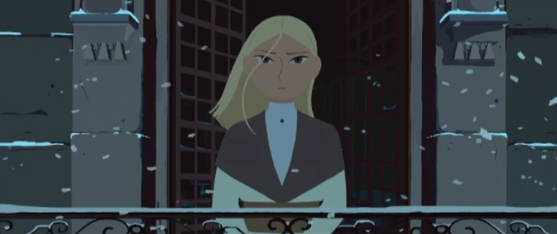
In his feature debut, artist and director Rémi Chayé, with screenwriters Claire Paoletti and Patricia Valeix, brings us the animated story of a 19th century Russian girl, the 14 year-old Sacha, whose aristocratic parents’ hopes for her are that she live up to her status as a “real young lady” and appease the political status quo with a suitable marriage. Sacha, however, her childhood imagination set fire by the stories from her seafaring, explorer grandfather, hasn’t much use for the balls and gowns of fine ladies. Her heart is set on seeking out this same grandfather, declared to be lost at sea in an expedition to the North Pole, but who, she believes, is still waiting for rescue. The story follows her path after she runs away from parents and her St. Petersburg home, and, applying her wits, her navigational knowledge, and her courage in a societal context that doesn’t expect much self-sufficiency from any girl, much less an aristocratic one, she eventually finds a passage on a northbound ship, where Sacha and the crew face the dangerous cold, crushing ice floes, and their own fears and conflicts.
Sacha’s sturdy character is a delight in a film landscape where female characters rarely take center stage, and she recalls the vibrant characters my daughters and I love so much in the Ghibli studio oeuvre: Chihuro of Spirited Away; Satsuki of My Neighbor Totoro; Sheeta of Castle in the Sky; Kiki; Arrietty; Nausicaä. While there is a slight nod to a possible love interest in Sacha’s story, the primary focus has very little to do with her male peers and much more to do with the adventures her deep convictions and life passions bring her. Sacha grows up on her journey north, her understanding of the world, of herself and her capabilities deepening through what she encounters and through those she meets, boys, men, and women alike. In fact, Olga, a gruff and kindly innkeeper, is perhaps the character with whom Sacha has the deepest connection and from whom she learns the most.
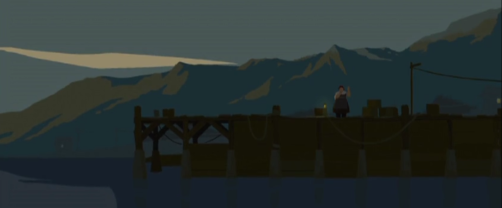
Like the Ghibli stories, too, which gently tap into real childhood sorrows and into the ways that life, inevitably, runs alongside death, Long Way North doesn’t sanitize its story for a young audience. While absolutely appropriate for young viewers, it nonetheless reminds us that loss may figure even into a happily ever after.
Perhaps the greatest delight of the film, however, if some of the story and character moments run slightly thin at times, is the beautiful and unusual hand-drawn animation, not quite like any animated film I’ve seen before. Chayé, as first assistant director on another gorgeously animated film, The Secret of Kells (Tomm Moore, 2009), was, he himself notes, first influenced by that film’s unique style, but moved away from that into something more fully his own: an animation style that uses line drawings only in the first stages of animation and later removes those outlines, leaving, in the finished version of the film, simply the color fills. The result is an often abstract, but evocative set of images, that look, at first, very simple, but leave an impression of layered beauty: of light and shadow and of soft colors. Morning scenes capture the particular way light falls on faces and on buildings and recreate the delicate pinks and yellows of dawn; evening scenes highlight the way lamplight and shadow fall on a room’s objects and the way our eyes perceive shapes as dark color blocks. And there are breathtaking scenes, where a landscape and characters are muffled in gray mist or in densely flying snow. Chayé’s vision is, truly, a painterly one, single stills recalling a Turner or the work of Ilya Repin, whom Chayé cites, along with other 19th century Russian painters, as an inspiration.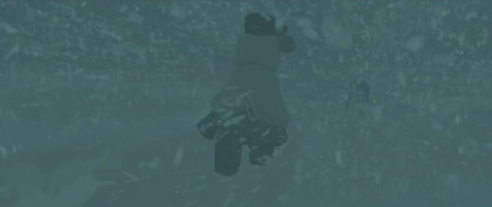
Those familiar with Ernest Shackleton’s near disastrous expedition to the Antarctic, where Shackleton and his crew became trapped in the ice and eventually had to abandon their ship, the Endurance, which was crushed in the ice, will also note the influence of the photographs taken (and miraculously preserved) throughout Shackleton’s travels. The film beautifully evokes the photos taken by crew member and ship photographer Frank Hurley: the icy landscape, the little dark figures, and the hapless, stranded ship.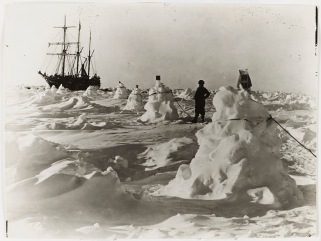
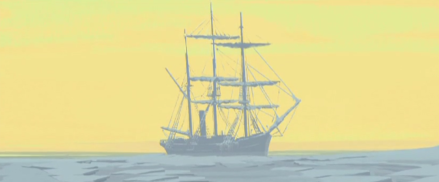
As a sort of exhibition of art or photos, the pacing of Long Way North, a refreshing contrast to the often manic action of much children’s animation, allows us to linger on a view of the ship, on the light on a St. Petersburg building, or on Sacha’s fingers on a compass, or to soak in the texture of the sound design – the ship’s creaking, rope pulleys swiveling, or gulls calling. But running at a slim 81 minutes, the story does not lag, and in the final moments, I felt the kind of satisfaction I hope for in a film: where the story pieces have fallen into place in a steady rhythm, but I leave with its mood and visual motifs hovering about my mind. One final shot, after the end credits, a small moment that’s nonetheless worth waiting for, further underscores the film’s poignant story, pricking at my heart in a way that the best children’s films do and reminding me that children’s films are for everyone.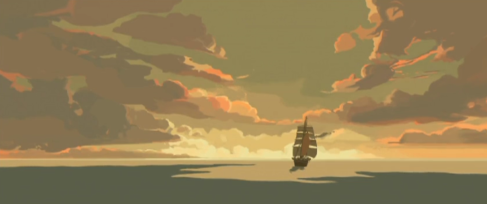
Long Way North screened at the 42nd Seattle International Film Festival on May 21 and 22 and will screen once more during the festival on May 29 at the Renton IKEA Performing Arts Center.
.

3 thoughts on “SIFF 2016: Long Way North (Rémi Chayé, 2015)”
Comments are closed.